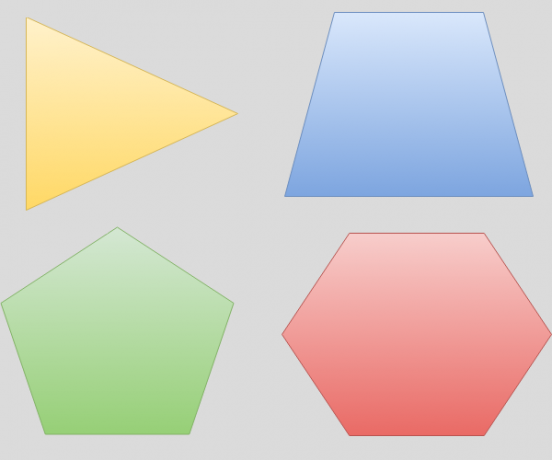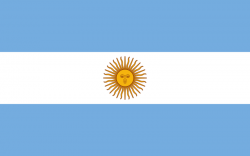A polygon is a geometric figure flat and closed formed by straight segments, called sides. According to the number of sides that form them, these figures have different names and formats.
An important feature to recognize a polygon is knowing that your straight segments never intersect, except at the ends.
 Polygons formed by 3 (triangle), 4 (quadrilateral), 5 (pentagon) and 6 (hex) line segments
Polygons formed by 3 (triangle), 4 (quadrilateral), 5 (pentagon) and 6 (hex) line segments
Polygon Types
Polygons are classified according to the number of sides that form them, receiving a different name for each shape. There are no polygons formed by just one or two straight line segments. But, from three segments, these geometric figures are already formed.
See the names of the different types of polygons, according to the number of sides they have.
| Number of sides | Name |
|---|---|
| 3 | triangle |
| 4 | quadrangle |
| 5 | Pentagon |
| 6 | Hexagon |
| 7 | Heptagon |
| 8 | Octagon |
| 9 | Enneagon |
| 10 | Decagon |
| 11 | Undecagon |
| 12 | Dodecagon |
| 13 | tridecagon |
| 14 | tetracagon |
| 15 | Pentadecagon |
| 16 | hexadecagon |
| 17 | Heptadecagon |
| 18 | octodecagon |
| 19 | Enneadecagon |
| 20 | Icosagon |
| 30 | triacontagon |
| 40 | tetracontagon |
| 50 | pentacontagon |
| 60 | hexacontagon |
| 70 | Heptacontagon |
| 80 | octacontagon |
| 90 | Enneacontagon |
| 100 | Hectagon |
Elements of a polygon
In addition to the sides that shape the polygons, they have other elements that are: vertices, diagonals and angles (internal and external).
You sides are all the straight segments that make up the polygon. You vertices are the meeting points of the straight segments and the diagonals are straight line segments that connect two non-adjacent vertices.
You inner angles are the angles formed by two consecutive sides of the polygon, located in its interior. already the outside angles are formed on one side of the figure together with the extension of the adjacent side.
 Parts of a Polygon
Parts of a Polygon
Convex and non-convex polygon
To find out if a polygon is convex or non-convex it is necessary to draw a line between two points belonging to it.
convex polygon
A polygon will be classified as convex when all the lines drawn are within the area of the polygon.
If the measure of all the polygon's interior angles is less than 180°, then it will be convex.
concave polygon
For a polygon to be classified as concave (or non-convex) it is enough that only one of the lines drawn crosses some point that is outside the area of the polygon.
 Convex polygon and concave polygon
Convex polygon and concave polygon
regular polygons
Polygons will be regular when they fit these requirements, called properties:
- all its sides have exactly the same measurement,
- all of its internal angles are congruent, that is, have the same measurement,
- are indescribable in a circle, that is, when all its vertices are points of the same circle.
non-polygon
Non-polygons are geometric figures similar to polygons, but that do not have all the elements that characterize them.
 not polygons
not polygons
The geometric figure will not be a polygon if you fall into one of these situations:
- if you have at least one crossing of straight lines,
- if it has a curvature.
See also the meaning of geometric shapes, Geometry and Pentagon and types of triangles.

